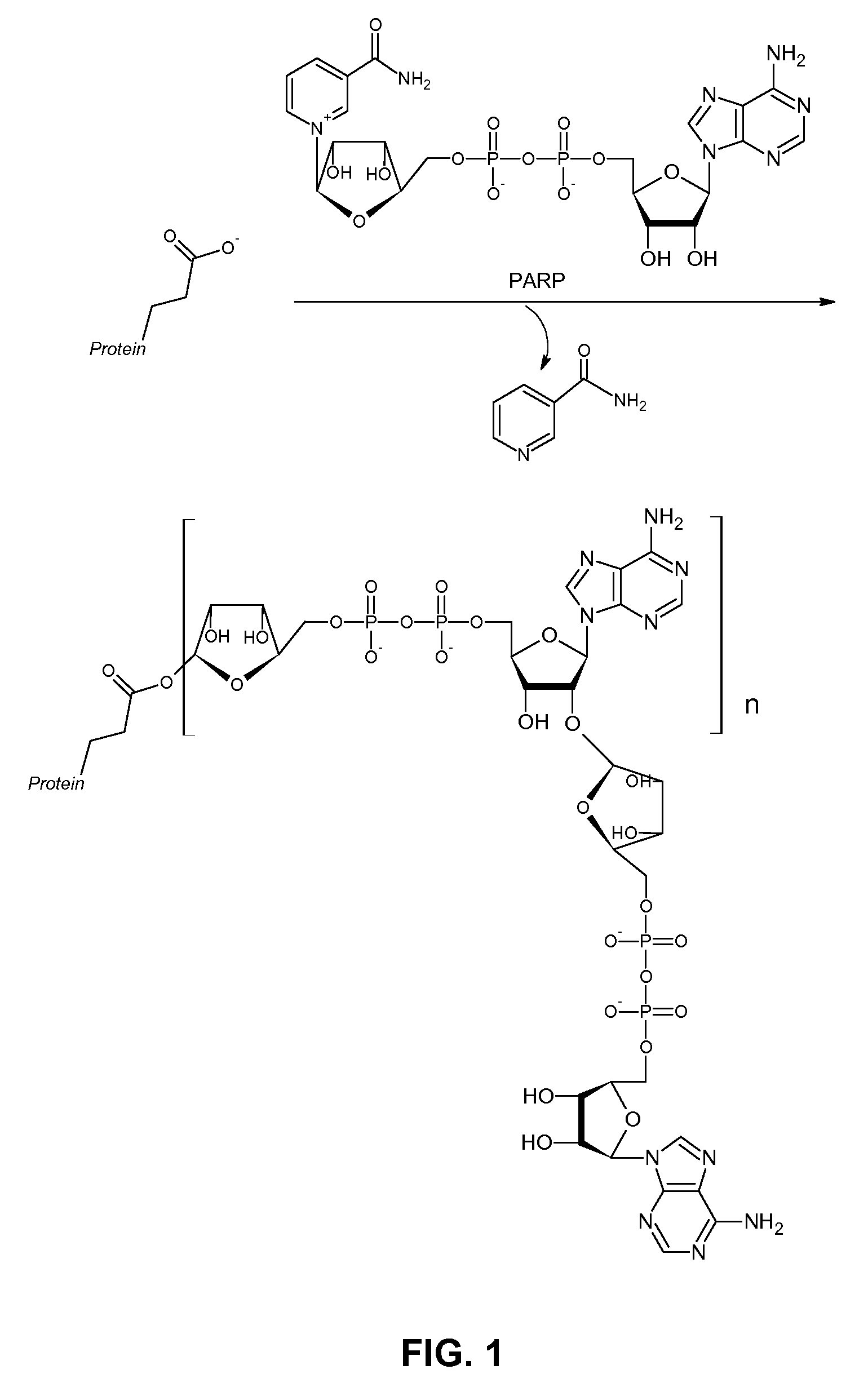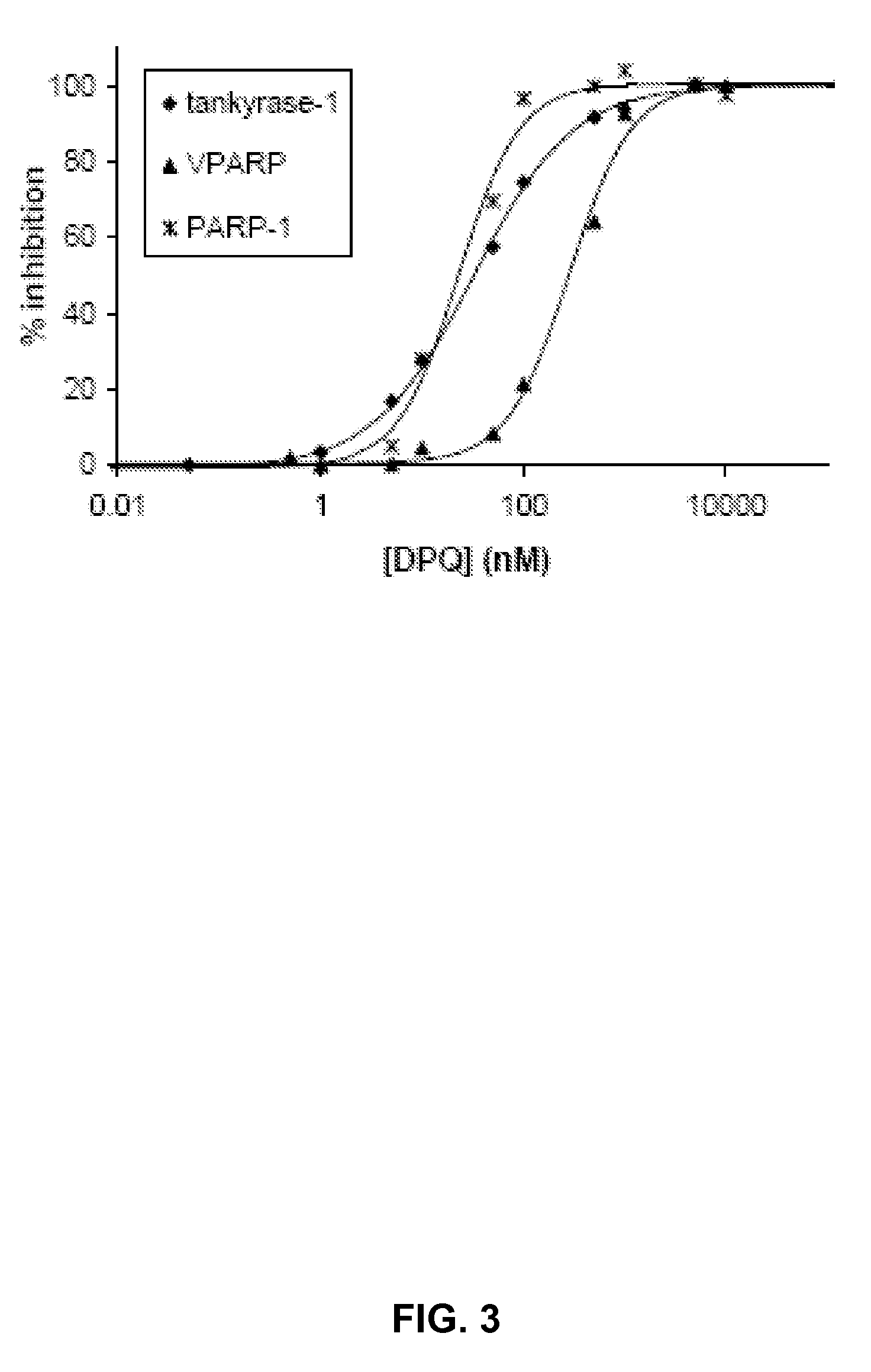Colorimetric Substrate and Methods for Detecting Poly(ADP-ribose) Polymerase Activity including PARP Enzymes PARP-1, VPARP, and Tankyrase-1
a colorimetric substrate and polymerase technology, applied in the field of colorimetric substrate and methods for detecting poly (adpribose) polymerase activity, can solve the problems necrotic cell death, and parp-1 overactivation, and achieve the effects of reducing the number of adpribose-specific parp inhibitors, reducing the number of adpribos
- Summary
- Abstract
- Description
- Claims
- Application Information
AI Technical Summary
Benefits of technology
Problems solved by technology
Method used
Image
Examples
example 1
Synthesis of Novel Colorimetric Substrate for PARP Enzymes
[0037]PARPs comprise a large family of about 18 putative isozymes. While basic enzymatic function and biochemistry has been characterized for at least six members of this family, much work remains to be done in this area. Although PARP-1 accounts for more than 90% of PAR synthesis upon DNA damage, it is now known that biopolymer synthesis by various other PARPs is critical in a variety of cellular processes. Particularly intriguing are the functions of tankyrase-1 (PARP-5) and VPARP (PARP-4). Unlike PARP-1, tankyrase-1 is not activated by DNA damage. About 10% of this protein is recruited to telomeres, and it has been shown that overexpression of tankyrase-1 can lengthen telomeres through its poly(ADP-ribosyl)ation of TRF-1. VPARP is most commonly found associated with vault particles, but can also localize to the nucleolus, nuclear spindle, or nuclear pores.
[0038]The ability to study PARP enzymes would be greatly augmented b...
example 2
Development of Continuous Assay for Monitoring PARP Enzymatic Activity
[0042]With the calorimetric substrate ADP-ribose-pNP in hand, a continuous calorimetric assay for PARP activity was developed and the kinetic parameters for three PARP isozymes were determined. In a 96-well plate, a range of concentrations of ADP-ribose-pNP in PARP assay buffer were incubated with either PARP-1 (DNase digested DNA was added to activate PARP-1), tankyrase-1 (refers to “active domain,” see Supporting Information), or VPARP (also refers to the “active domain”), and the optical density at 405 nm was measured every 60 seconds over a 2 hour time period. Change in absorbance was assessed in triplicate, and blanks containing 0 to 700 μM ADP-ribose-pNP in PARP assay buffer were also measured over the same time period. The absorbance of a range of p-nitrophenol concentrations was determined at 405 nm, and the slope of this calibration curve (see Supporting Information) was used to convert the absorbencies t...
example 3
Supporting Information
[0046]Reagents. High specific activity PARP-1 was purchased from Trevigen. β-NAD+, p-nitrophenol, and 3,4-dihydro-5-[4-(1-piperidinyl)butoxy]-1 (2H)-iso-quinolinone (DPQ) were purchased from Sigma-Aldrich. DMSO and triethylamine were distilled and stored over molecular sieves prior to use. PARP assay buffer consisted of 50 mM Tris, 2 mM MgCl2 at pH 8.0, and was freshly prepared before each experiment.
[0047]General Methods. 1H NMR and 13C NMR spectra were recorded on a Varian Unity 500 MHz, 1H (125.7 MHz, 13C) spectrometer or a Varian Unity Inova 500NB. Chemical shifts are reported in parts per million (ppm), and multiplicities are denoted as s (singlet), d (doublet), t (triplet), m (multiplet), and br (broad). Spectra were referenced to d6-DMSO (1H 2.49 ppm, 13C 39.5 ppm) or D2O (1H 4.65 ppm). Mass spectra were obtained by the University of Illinois Mass Spectrometry Center and the data is reported as m / z. Analytical thin layer chromatography (TLC) was performe...
PUM
| Property | Measurement | Unit |
|---|---|---|
| Volume | aaaaa | aaaaa |
| Length | aaaaa | aaaaa |
| Length | aaaaa | aaaaa |
Abstract
Description
Claims
Application Information
 Login to View More
Login to View More - R&D
- Intellectual Property
- Life Sciences
- Materials
- Tech Scout
- Unparalleled Data Quality
- Higher Quality Content
- 60% Fewer Hallucinations
Browse by: Latest US Patents, China's latest patents, Technical Efficacy Thesaurus, Application Domain, Technology Topic, Popular Technical Reports.
© 2025 PatSnap. All rights reserved.Legal|Privacy policy|Modern Slavery Act Transparency Statement|Sitemap|About US| Contact US: help@patsnap.com



